Women's monthly magazines:
Deluxe to Grazia
This page links to profiles of women's monthlies, many of which are
known as glossies (or slicks in the US) because of their varnished or laminated covers, high production values
and upmarket editorial. Some weekly women's magazines – such as Grazia and Riva -
are included because of their attempts to establish themselves as weekly
glossies. The main index page is here.
The titles – past and present – are arranged alphabetically on the
following pages
- 19 to Cosmopolitan
- Deluxe to Grazia [this page]
- Harper's Bazaar to More!
- New Woman to Over 21
- Queen to Riva
- Sense to Zest
- Table of top 5 sellers
- Key facts on women's monthlies
 Deluxe first issue |
Deluxe [closed]Fashion monthly, 1977-? |
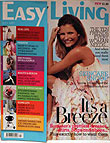 Easy
Living – note use of false half-cover to promote colour-coded sections Easy
Living – note use of false half-cover to promote colour-coded sections |
Easy Living [closed]Condé Nast, monthly, March 2005-2013First Condé Nast launch since Glamour in 2001 aimed to attract women aged 30-50. Given a marketing budget of £15m to set it up against NatMags' Good Housekeeping. The target sales figure was 150,000-200,000; came in with first ABC of 171,038 copies. Its suspension (ie closure) was announced in May 2013 and blamed on challenging newsstand conditions. However, the title was regarded as performing well in a struggling women's lifestyle sector, although sales were down from a peak of 200,000 in 2007 to 150,000. Nicholas Coleridge, MD of Condé Nast UK, said there were 'few encouraging signs in this part of the market, with challenges at the newsstand and an increasing reliance in the sector on multi-bagged offerings'. He added that 'our digital reach far outweighs that of print, and Easy Living is thriving online,' although if this was the case it did not last long. Condé Nast profile |
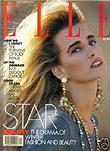 Elle – ultimately owned by Lagardère Media, the world's top magazine publisher 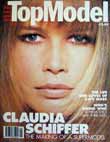 Top Model – an Elle spin-off with Claudia Schiffer on the cover of the first issue |
ElleHachette Filipacchi UK, monthly, 1985- In the early 1990s, there was a series of Elle Top Model specials
of 100 pages. The first was about Claudia Schiffer. |
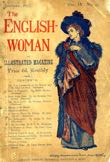 The Englishwoman, January 1897 with standard cover design by Linley Sambourne |
The EnglishwomanSimpkin, Marshall, Hamilton and Kent, monthly, 1895-1899. Editor: Ella Hepworth DixonThe Englishwoman was a sixpenny illustrated women's magazine published on the first of each month at 123-5 Fleet Street. The standard cover design was by Punch illustrator Linley Sambourne. His diaries say that 'Miss Ella Hepworth Dixon [the magazine's editor] dined with us to talk over cover for The Englishwoman' on 16 December 1894. He started on the design on January 14 and finished on the 23rd. However, on February 1, 'Miss Hepworth Dixon called & said they did not like the drawing.' He worked on it again and was 'bothered' with it on February 4. It is not mentioned again. Sambourne based many of his drawings on his massive collection of 30,000 photographs. His home at 18 Stafford Terrace in London is today a museum to his work. Hepworth Dixon was a novelist best known for The Story of a Modern Woman (1894). She had taken over the editorship of Woman's World in 1888 from Oscar Wilde. |
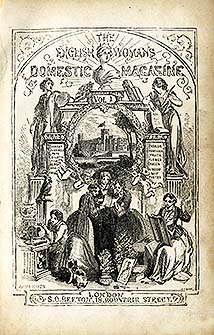 Title page from the 1852 bound volume of Englishwoman's Domestic Magazine 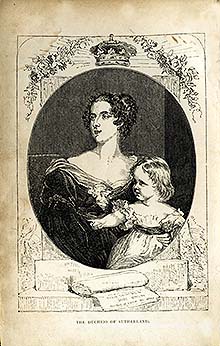 Frontispiece plate of the Duchess of Sutherland from the 1852 volume 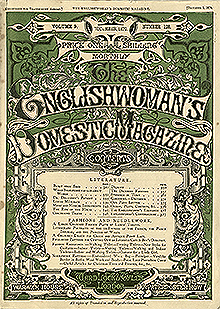 Cover of the relaunched, larger format 1860 issue |
The Englishwoman's Domestic MagazineSamuel Orchart Beeton / Ward, Lock and Tyler, monthly, 1852-1879The Englishwoman's Domestic Magazine was a groundbreaking monthly, launched by Samuel Beeton with his wife Isabella (better known as Mrs Beeton). Her Book of Household Management was based on recipe submissions to the magazine. After Isabella's untimely death, Beeton lost control of the magazine, and his other titles such as The Queen, to Ward Lock. Large inserts of dressmaking patterns and colour illustrations printed in Paris of the latest fashions were important attractions for readers. Beeton published an edition of Uncle Tom’s Cabin by Harriet Beecher Stowe in 1852. The first issue of Englishwoman’s Domestic Magazine carried an excerpt from the book. The frontispiece plate from the 1852 magazine bound volume shows the Duchess of Sutherland with her daughter and is based on an 1828 portrait by Sir Thomas Lawrence. Sutherland was Mistress of the Robes to Queen Victoria four times and was a great friend of the queen. Beneath the portrait is a scroll engraved ‘From the ladies of England to their sisters in the United States. Sutherland.’ The duchess had led the writing of a letter against slavery signed by half a million women that was given to Stowe in 1852. In January 1863 during the American Civil War, Stowe quoted the Englishwomen’s letter in the Atlantic Monthly to remind the British that they should come out in support of the anti-slavery North of the US in the war. A later Duchess of Sutherland was the frontispiece for the first issue of The Tatler in 1901 (3 July). |
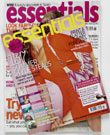 Essentials - adopted a cut-down 'convenience' format in 2005. It also adopted the strange habit of cutting the heads off the cover models |
Essentials [closed]Time/IPC Media, monthly, 1988-Dec 2016IPC aimed this women’s lifestyle monthly magazine at 'women who are at the beginning of grown-up life: the serious relationship, the first house and first child. They are in their late 20s to mid 30s.' Essentials folded with six redundancies in December 2016, with publisher Time Inc UK blaming its efforts to focus on digital growth. Sales were down a quarter year-on-year, at 78,000 copies. The magazine's articles were online at lifestyle website Goodtoknow.co.uk. It had been relaunched in 2005 with a handbag format, but in December 2006 IPC announced it was to aim for an older audience and revert to an A4 format. Back in 1988, it was part of a response to the arrival of German
companies Bauer and G+J in 1987. Essentials was
pitted against Bauer's practical women's monthly Prima.
(Other IPC launches in 1988 being Marie Claire
in partnership with Groupe Marie Claire and Riva). Essentials then
launched in France by Groupe Marie as Avantages. |
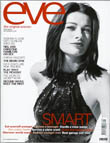 Eve – the BBC was forced to sell the title in 2004 to Haymarket. However, it was on a limb at Haymarket, which has always been a male-dominated company, and it closed in 2008. |
Eve [closed]BBC/Haymarket Publishing, monthly, September 2000 – November 2008Launched by BBC Magazines against Emap/Hachette's Red and IPC's revived Nova for maturing women who had outgrown Cosmo and Elle. 'The original woman' read the strapline. The sector was described as ‘middle youth’. As a women's monthly magazine, Eve was a slow burner but was increasing sales when the BBC was forced to announce a sale in late 2004 after political pressure on magazines not based on programmes. Yet Haymarket closed Eve – its only women’s magazine – in 2008, after sales fell 5% year-on-year to 155,076 copies.
It was seen as the first glossy victim of the credit squeeze, just five months after a relaunch. However, Haymarket kept on the website spin-off evecars.com, launched in 2005 with What Car? (Haymarket tried a similar idea in 1999 with Your Car, which was run by What Car? and Gruner + Jahr’s Prima.)
Haymarket also used the brand on events, such as Eve Educates and
the 2006 Eve Style Show, alongside Clotheshow Live. |
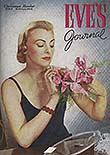 Eve's Journal (1937) |
Eve's Journal [closed]Small format monthly published by Pearson |
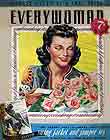 Everywoman. This May 1940 issue featured a 'Budget for the wartime bride' – costing £23 18 1/2d for the wedding dress and honeymoon outfits, right down to the undies (of course, you made your own from patterns) 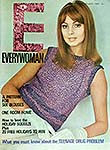 Everywoman – now E –
in 1967, its final year
Everywoman – now E –
in 1967, its final year
|
Everywoman [closed]Odhams Press, monthly, 1934-1967The title was originally Everywoman's but this was shortened to Everywoman in 1940. The title became Every Woman and Woman’s Fair in the 1950s after it absorbed that magazine. In the mid-1960s, it also took over Modern Woman before being swallowed itself by Woman at Home. Everywoman was a monthly bestseller for Odhams over many years, estimated at 100,000 in the late 1930s and reaching about 300,000 in the late 1950s (historical sales table). A border around the main image of the 1940 issue shown here listed the coverage: fashion, fiction; knitting; embroidery; homemaking; beauty; and cookery. At that time, the editorial offices were in Martlett House, Martlett Court, Covent Garden, close to the Odhams HQ in Long Acre. The magazine was printed by Odhams, at St Albans Road, Watford. A service for readers was the Advertisers Service Bureau at 57 Long Acre, which provided details of advertisers and samples. Odhams became part of IPC in 1963 |
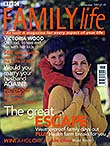 First issue of BBC Family Life magazine from 1997
First issue of BBC Family Life magazine from 1997 |
Family Life [closed]Editor Anita Bevan described this launch as: ‘At last! A magazine for every aspect of your life.’ The BBC's Redwood magazines division had already upset other publishers when it began launching magazines branded to programming, such as Gardener's World. General interest titles such as Eve (above) and Family Life enraged them further |
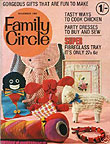 Family Circle – in 1966, this women's monthly was only sold in supermarkets |
Family CircleStandbrook Publications (Thomson group)/IPC Media, monthly, 1964-2006For more than 20 years, Family Circle (a name licensed from the US) and Living were solely sold in supermarkets. Their owner, International Thomson Publishing (ITP), had a monopoly and they were the only consumer magazines the company ran. It did, however, produce book spin-offs, such as Successful Slimming – How to Eat Well and Lose Weight in 1974 and many others since covering cooking, crochet and sewing. The magazines were very profitable, with Family Circle selling more than 580,000 copies by 1984, making it the top seller among women's monthlies. Research by Associated Newspapers found that women who bought make-up were most likely to buy Cosmopolitan or Family Circle. However, two significant threats appeared. First, mainstream publishers started to explore distributing their women's monthly magazines through supermarkets, so ITP held talks with magazine wholesalers about selling its duo in newsagents. Then, in 1986, German publisher Gruner and Jahr launched Prima in the UK. Within a couple of issues, Prima was claiming to have overtaken Family Circle as the UK's best-selling women's monthly. ITP denied the claim, saying its own sales had risen to 585,000, and responded by launching three Family Circle spin-offs. Then, in 1988, IPC Magazines owner Reed paid £28m for the ITP titles. It closed after circulation had dropped from 625,000 in 1988 to 113,000. IPC profile |
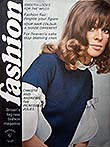 First issue of Fashion magazine from 1968: Joyce Hopkirk was assistant editor
First issue of Fashion magazine from 1968: Joyce Hopkirk was assistant editor |
Fashion [closed]Published by Fleetway Publications, Fleetway House, Farringdon Rd, EC4Fashion was a large format fashion monthly. The editor was Aisla Garland with Joyce Hopkirk as assistant editor. Hopkirk would become launch editor for Cosmopolitan four years later. The copywriter was Penelope Labovitch, 26: ‘married to a publisher and has 2 small children’. She wrote Late Start: Careers for Wives and The Working Wife's Cookbook |
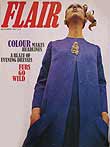 Flair - this issue from November 1967 cost 2/6 for 124 pages. The editor was Emma Powell |
Flair [closed]George Newnes, Tower House, Southampton St, London WC2. 1960?-1972?Large format (320mm x 240mm), perfect-bound fashion monthly. Was published as Elegance in New Zealand and Australia. Newnes became part of IPC in 1968. One of its fashion editors was Jean Rook, who later became known as 'First Lady of Fleet Street' and 'First Bitch of Fleet Street' on the Daily Express. She claimed to be the highest-paid woman in newspapers and was the inspiration for Private Eye's Glenda Slagg. George Newnes became part of IPC in 1963 |
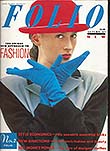 Second issue of Folio magazine from 1987 |
Folio [closed]Folio was a fashion quarterly that launched in spring 1987 |
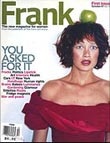 Frank - from its first issue, above, Wagadon's women's monthly set out to be different 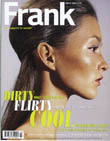 |
Frank [closed]Wagadon, monthly, October 1997-1999Editor Tina Gaudoin tried to launch a more intelligent title for the women's monthlies sector, but the result was seen as too edgy. An A4 sample was distributed just before the launch with the Observer. Frank's closure and the failure of music/film monthly Deluxe (May 1988 launch) was to drain Face and Arena publisher Wagadon. The company sold out to Emap in early 2000. Wagadon profile |
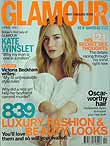 Glamour -
with English actress Kate Winslet on the cover for the launch
issue Glamour -
with English actress Kate Winslet on the cover for the launch
issue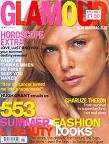 A later, more aggressive look for Glamour |
GlamourCondé Nast, monthly, April 2001-21 (then digital only)Sector-leading glossy that overtook Cosmopolitan within a year of launch. Editor was Jo Elvin (who launched B). Sales rose continually until the first half of 2005. In 2010 they were 526,216 a month. Glamour started a trend for handbag-sized A5 women’s magazines.
Founded in US in 1937, where it is Condé Nast's biggest
selling women's monthly (A4 size) with 2.2m circulation. Glamour's
'handbag' size has been credited to the Italian edition launched
in 1994. However, such a size had been popular in Britain until theh 1970s, for both men's and women's monthlies. In October 2017, Glamour announced it was going 'digital first. The November issue would be the last monthly print edition. Instead, it would produce a 'collectible, glossy' issue twice a year.
|
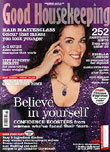 Good Housekeeping – Nigella Lawson on the November 2005 cover |
Good Housekeeping (UK)The National Magazine Company, London. Monthly, March 1922-Good Housekeeping aims to attract older women (the typical reader is 51), trading on trust and its expertise. Editorial strategy is to give readers direct access to the 'best of everything' with information and advice on food, home and family, fashion, relationships, health and beauty. Good Housekeeping drew on its heritage to see off the threat from Easy Living’s arrival in 2005 with a relaunch under editor-in-chief Lindsay Nicholson that saw it beat Cosmopolitan for the number-two sales spot. Good Housekeeping was first published in 1885 in the US and bought by NatMags parent Hearst in 1911. National Magazines profile |
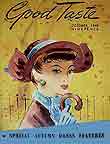 Good Taste – front cover from the October 1948 issue with 'special autumn dress features' |
Good Taste [closed]Weldon's/Amalgamated, London. Monthly, ?1938-1953?Pocket format women's magazine with fiction (3 short stories by Nora Burke, Poppy Richard and Madge Harte), fashion and beauty, home and general articles on cinema, books and readers' opinions and problems. Good Taste was one of the most popular women's monthlies in the early 1950s, selling about 100,000 copies each issue. The copy shown here (October 1948) ran to 96 pages (including cover) and cost 9d. The contents were on page 17. One of the leading features was about the ballet film The Red Shoes. It was saddle-stitched with the same paper used for the cover as inside. The cover was colour only on the outside and there were 11 pages inside featuring colour or spot colour (used for ads and editorial). The issue was printed by Sun Printers (London & Watford) and came out on the 30th of each month. Amalgamated had its head office at Fleetway House, London EC4, but the magazine's advertising and editorial base was at 30-32 Southampton St, WC2. Amalgamated was renamed Fleetway in 1959 when it was taken over by Mirror Group, which in turn became part of IPC in 1963 |
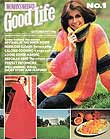 Good Life – practical cover with contents for the first issue of this 1977 Woman's Weekly spin-off |
Good Life (closed)IPC magazines, London. monthly, October 1977-?Editor Mary Dilnot chose a pocket format (6.75x 8.5in; 176 x 216 mm) for this spin-off from Women's Weekly. It cost 20p for 100 pages. Articles included: Come Behind The Scenes: Upstairs At The White House; Fabulous Cloaks Pattern Offer; Calorie Cooking (4-page pull-out); Loose Cover Making; Deborah Kerr star profile; Perfect Patchwork; serial ('Visitors to the spa' by Evelyn Charles); fiction ('A Taste of Sherbert' by Lesley Wilson); as well as the regulars such as a horoscope, letters, etc. Unusually for a women's
magazine, Good
Life also
carried an advertisers' index. |
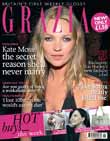 Grazia – marketed as 'Britain's first weekly glossy' |
GraziaEmap/Bauer, weekly, February 2005-Title aims to become the weekly Vogue and is built on an Italian formula. Posted a first sales figure of 155,157 copies, beating its target of 150,000 copies. In the first half of 2010, sales were 228,770 a week. Marketed as 'Britain's first weekly glossy'. Focus is on fashion, though led by celebrity covers (Jennifer Aniston, Kate Moss, Nicole Kidman for the first three issues). A massive £16m launch budget saw 650,000 taster copies being given away in shops a week before the actual launch. Editor Fiona McIntosh recruited a heavyweight team that included no less than five former editors of women's magazines. Approach had been tried by Carlton's Riva in 1988. |


